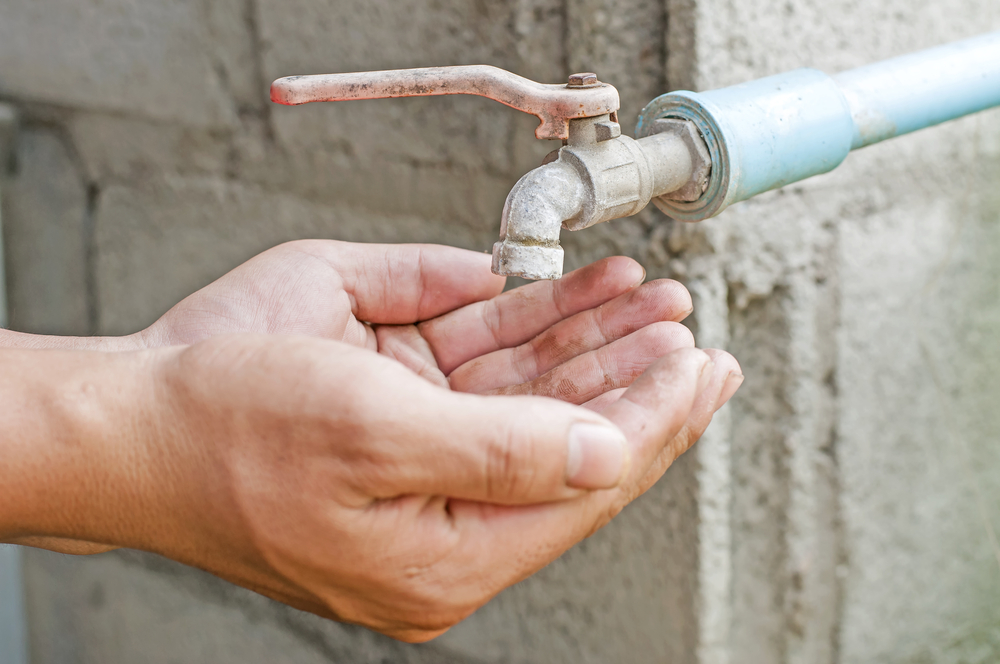
Across the globe, countries and communities are asking, with fear: Do we have enough water? But fear, in many places, has not transformed into action, and the forces that have spurred concern about water shortages—climate change and development—appear undiminished. In advance of a Zócalo/Occidental College half-day conference, “How Will We Survive the Water Wars?” we asked water experts: Given that technology advances have allowed us to survive a number of doomsday warnings about our supply of non-renewable resources like food and oil, why should we be worried about the water issues that scientists currently see on the horizon?
Charles Fishman
Because while our water problems can be solved, they can’t be solved quickly, or easily.

One of the magical qualities of water is that it is completely reusable.
If you brew yourself a morning cup of coffee, the water you use emerges from your body before lunchtime, almost ready to use again to make another cup of coffee. It needs a little cleaning, sure, but nothing too taxing.
Likewise, the water a farmer uses to grow 1,000 acres of carrots—a small lake—re-emerges ready to use again, for growing carrots, or for anything else we might want it for. The water from the carrot fields won’t be exactly where it started. It may have seeped back into the groundwater; much of it will have evaporated and will fall as rain somewhere else.
You can’t use the coffee grounds you used to brew that cup of coffee to make another cup of coffee. The diesel fuel powering the carrot farmer’s tractor can’t be re-used again as diesel fuel.
So no, we’re not using up our water. In fact, we’re using the same water that your typical Tyrannosaurus rex made coffee with.
But here’s the problem: We can run out of water without using it up.
We’ve built our cities and planted our crops in relation to the water supply.
You cannot pack up Los Angeles and move it somewhere else when the water runs short. Los Angeles could, in fact, run out of water.
You can’t trade lushly productive farmland in the Imperial Valley for farmland in Alberta, if you use up the available water.
Water falls where nature sends it, and water is very hard and very expensive to relocate. The water system of California and much of the western U.S. is engineered. That engineering depends on rain and snow falling in accustomed places, and flowing into the lakes, reservoirs, underground aquifers and canals where we need it and expect it.
When that stops happening, we’re in big trouble. Even a 20 or 30 percent drop in available water is a crisis for most places.
We were warned in dark terms by experts about running out of food and running out of fuel. Those warnings weren’t wrong—we revolutionized how we grow food, and how much we grow, precisely because we faced a global crisis. The world is working furiously every day to broaden sources of power.
The warnings weren’t a case of “crying wolf.” They haven’t come true because we heeded them.
We need to do the same for water.
Rainfall and snowfall are shifting dramatically in location, driven by climate change. Economic growth and population growth both demand more water. As people move from poverty into the middle class, their water use surges. For all these reasons, water supplies are coming under pressure.
The good news is, most water problems are solvable. We need to change our habits and our management of water, but we have the technology we need.
The bad news is that water problems are not solvable quickly. Dramatic change in water use is possible, but typically happens 2 or 3 percent a year. That’s why it’s urgent to tackle water problems—particularly in California—today.
The early signs of crisis are everywhere. That’s fair warning to a smart society to imagine how we need to use water differently over the next 10 and 20 and 50 years.
It’s especially important because of another often-overlooked quality of water. You can eat chicken, or you can eat wheat, or you can eat rice. You can run a factory on hydropower, or natural gas, or solar.
But there is nothing you can pour over your ground coffee that will make coffee, nothing you can spray across the carrot fields that will make carrots, except water. You’ve either got the water you need, or you’re in trouble.
Charles Fishman (cnfish@mindspring.com) is a journalist and the author of The Big Thirst: The Secret Life and Turbulent Future of Water, now the best-selling book about water in 25 years.

“Water wars” are really about food and livelihoods rather than drinking water. But conflicts between human societies are not the only matter of concern. An equally big concern is that we will lose the world’s last remaining wetlands and aquatic ecosystems first.
The growth and transportation of the food we consume requires 15 times more water than household uses. It’s true that many people still don’t have access to enough clean water to drink and keep themselves clean. But these problems are not about having enough water per se; they are usually problems of mismanagement, politics or insufficient investment. Access problems tend to be local and solvable with money and technology.
When people talk about “water wars” they are usually referring to conflicts over sharing major water bodies—the Indus, Ganges, Mekong, Nile, Jordan—for economic use by agriculture and industry. Unlike oil, water is both a renewable resource and a non-renewable one (as in the case of fossil water in aquifers) so the “conflict” is both between current users as well as with future generations. Unlike oil, water has no substitute. While we may genetically modify crops to use less water, we cannot do away without water entirely.
While we need a lot of water to grow food; we probably have enough at a global scale. One modeling exercise by the World Water Council showed that the world’s renewable freshwater resource—the amount of rain falling on the earth’s surface each year—is sufficient to support the global population, provided they follow mostly low-water intensity diets, invest in infrastructure, and implement sensible policies. Although these water resources are not evenly distributed, global trade should ensure that water-scarce regions can import food. In other words solutions exist, but technology alone will not solve the problem; policies and changes in lifestyles are also necessary.
While conflicts between countries are likely to remain rare, regional and ethnic conflicts between communities are not. Conflicts rooted in competition over water may escalate and develop political and cultural dimensions. Many places in the world do not have sensible policies and lack the capability to enforce rules on water. In some regions, rivers are going dry because of perverse incentives to farmers, combined with increasingly cheap pumping and lifting technologies. In the developed world, less than 5 percent of the population and a small fraction of GDP depend on agriculture, so, if one place “runs out” of water, a few corporations will go out of business and some people will relocate, but without any major economic disruption. But in many developing countries, between 60 and 90 percent of the population, and a significant proportion of the GDP, depend on agriculture. Here, if an aquifer or river dries up because of overuse, millions of people could lose their livelihoods and be left without any way to feed themselves—a recipe for serious conflict.
Whether or not water scarcity results in conflict between humans, competition between humans and nature is inevitable. The more pressing question is whether we will lose all our freshwater ecosystems before societies recognize the problem and the technologies and policies come into effect. Ninety percent of the world’s wetlands have already disappeared. If water continues to be extracted for human uses at the current pace, it may already be too late. We may not see a water war but we will certainly see tragedy.
Veena Srinivasan is a Fellow at the Ashoka Trust for Research in Ecology and the Environment (ATREE), Bengaluru.

It is doubtful that the sorts of technological advances that have deferred or mitigated (but not resolved) world shortages of food and oil will do the same for water. Innovations aimed at increasing supply, such as desalinization, can help in particular locales, but they are expensive and often produce damaging environmental side effects. Improved exploration and extraction techniques can help find and exploit new groundwater sources, but in much of the world we are already draining aquifers at an unsustainable pace. Traditional approaches to securing supplies of surface water—dams and reservoirs—have a role to play in storing water so it is available when needed, but their construction and operation can have catastrophic environmental, social, and economic impacts on river systems and local communities.
Shortages of many resources can be addressed by switching to an alternative or engineering a new one: natural gas for oil; high yield, pest-resistant varieties for traditional crops. This is not the case with water. We cannot replace it with something else. We cannot manufacture a substitute or a “new and improved” version. Water is the indispensable resource.
The good news is that conservation and efficiency can make available new and inexpensive water supply. That is what is happening in Seattle, Washington where, since 1990, water use has fallen 30 percent even as the population has increased 15 percent. It is what is happening across Africa and Asia, as new techniques for growing rice are boosting yields with a fraction of the water used in traditional rice paddies. Water reuse; efficient, leak-free water delivery systems; improvements in agricultural, industrial, and domestic water-use efficiency; and protection of source water areas such as forests and wetlands are all strategies for conserving water resources to satisfy growing demands. As climate change and burgeoning populations exert ever more pressure on water resources, the answers lie in better management of the water we already have.
Wm. Robert Irvin is President and CEO of American Rivers, a national conservation organization based in Washington, D.C. that protects wild rivers, restores damaged rivers and conserves clean water for people and nature.

Unlike energy and food, the amount of water on our planet is finite. No matter how innovative we are, we cannot produce more. But rather than looking after this finite heritage with great care, we are polluting, mismanaging and displacing it with abandon. Whole rivers and lakes are disappearing. By 2030, demand for water worldwide will outstrip supply by 40 percent. And by our movement of water from its landscapes of origins, away from rivers and mountains to drier places, we are helping to cause global warming, as the new deserts left behind negatively impact the water cycle.
In my book Blue Future, I call for a new ethic that puts water at the center of our lives and measures all policies and practices, from how we grow food to how we trade across borders, by their impact on water. We need a new reverence for water if we and our planet are to survive.
Maude Barlow is the national chairperson of the Council of Canadians and author 17 books, including her latest, Blue Future: Protecting Water For People And The Planet Forever.

For California and other wealthy parts of the world, it is possible to get drinking water by desalinating seawater or brackish water, or by using soil-aquifer treatment of treated wastewater as many cities in the American Southwest do these days. But technologies come with costs. For example, as fresh water becomes less available for irrigating crops, technologies are also available to use wastewater or brackish water for irrigation. But these will reduce the quantity of water available for irrigation by making the water more costly, hence less crop production and higher prices. Still, the effects will be gradual, and the population in these locations can adapt their lifestyle to such conditions.
However, the situation will be quite different in poorer or developing nations. As the flows are reduced in rivers due to climate change, the upstream states will be tempted to keep more water than their share so that they can use that water for crop production. If two neighboring countries are hostile to each other, this can lead to conflicts (Egypt vs. Ethiopia; Turkey vs. Syria/Iraq; Pakistan vs. India).
Countries with economies heavily tied to agriculture will suffer the most. These countries are less resilient as they do not have the necessary diversification in their economy to withstand droughts and floods. Food import can drain their treasuries.
In our research at the University of Nebraska, we are seeing more and more extreme flood and drought events, and the resulting environmental and economic damage are often associated with impending climate change. The frequencies of such events seem to be increasing too.
This is a human problem, since the amount and affordability of food is key to human nutrition and survival. Even in India, where technological advances have been remarkable, hundreds of millions of people have stunted growth due to poor nutrition in the first 1000 days of childhood (counting from conception to their second birthdays). High protein diets and mother’s milk are essential in these cases. Water is needed for producing milk or animal meat and the animal feed needs to be grown with water. Diminished food production and high prices will lead to having more stunted children in South Asia and Africa (and parts of South America and Southeast Asia). In essence, we have to worry about water not only for drinking, but more so for food production.
Chittaranjan Ray is director of the Nebraska Water Center at the University of Nebraska-Lincoln which is part of the Robert B. Daugherty Water for Food Institute at the University of Nebraska.



